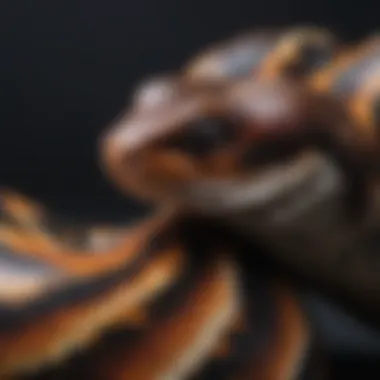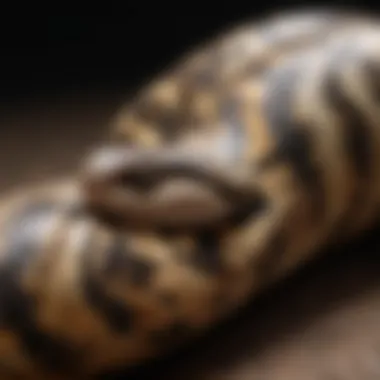Explore the Ball Python Market: Care, Morphs, and Ethics


Intro
The ball python market has gained substantial traction in recent years, attracting various groups of individuals interested in owning these fascinating reptiles. Before delving into the specifics of purchasing ball pythons, it is essential to understand the complexities surrounding their care, the different morphs available, and the ethical considerations involved in their acquisition. This guide aims to inform potential buyers about these aspects, emphasizing responsible pet ownership from selection to care.
Fascinating Facts About the Animal
Ball pythons (Python regius) are notable for several unique characteristics that separate them from other snake species. Originating from West and Central Africa, they often inhabit grasslands and open forests. Their name derives from their behavior of coiling into a ball when threatened. This instinctual response serves as an effective defense mechanism, providing both physical protection and psychological reassurance.
Unique Characteristics
One of the primary attractions to ball pythons is their remarkable array of morphs. These morphs result from selective breeding practices, leading to an assortment of colors and patterns. Common morphs include the pastel, ghost, and piebald variations. Each morph possesses distinct visual features, making them appealing to both novice and expert collectors alike.
Extraordinary Abilities
Ball pythons showcase extraordinary abilities, with their physical adaptations assisting in both hunting and self-defense. They primarily use heat-sensing pits located on their jaws to detect warm-blooded prey, enabling them to hunt effectively, even in darkness. Moreover, their slow metabolism and ability to survive on infrequent meals make them suitable for those new to keeping reptiles, as long as proper care is taken.
Behavior and Habitat
Understanding the behavior and habitat preferences of ball pythons is crucial for potential owners. Knowledge of their natural behaviors can aid in creating an appropriate environment that promotes their well-being.
Natural Habitats
In the wild, ball pythons typically reside in grasslands, savannas, and occasionally in forests. They prefer areas with ample cover where they can hide from predators. Their inclination towards burrowing also influences how owners should design their enclosures, incorporating hiding spaces and secure substrates for their comfort.
Social Structures
Ball pythons are generally solitary creatures; they do not require social interaction with other snakes. However, they do display remarkable adaptability when exposed to human care. Handling and appropriate socialization can lead to gentle and manageable pets. Nevertheless, any introduction to other snakes should be approached with caution to prevent stress or aggression.
Recent Scientific Discoveries
Recent scientific studies have continued to shed light on the biology and behavior of ball pythons, leading to insights beneficial for both enthusiasts and biologists.
Latest Research Findings
Recent findings suggest that ball pythons have remarkable adaptability to varying environmental conditions. With climate change posing threats to their natural habitats, studies indicate that these snakes may develop behavioral changes to improve survival rates under new challenges.
Breakthroughs in Animal Biology
Advancements in genetics have provided deeper understanding of ball python morphs. Researchers have identified specific genetic markers associated with various traits, which can help breeders predict combinations and improve the health of future generations.
Cultural Significance
The ball python's presence in various cultures illustrates its significance beyond mere pet ownership. Their depiction in folklore and art showcases the snake's profound influence.
Animals in Folklore
In different societies, snakes often symbolize wisdom and transformation. Ball pythons, in particular, have appeared in African tales, emphasizing a connection to the earth and the cycles of life.
Influence on Art and Literature
Various artists have drawn inspiration from ball pythons, depicting them in paintings and sculptures to symbolize beauty and mystique. Literature often uses snakes as symbols of both danger and allure, positioning them as compelling subjects for storytelling.
“Understanding the complexities surrounding the care and purchase of ball pythons is paramount for developing a deep appreciation for this species.
Preamble to Ball Pythons


Ball pythons have gained considerable attention in the pet trade. Understanding their nature, care requirements, and the intricacies of their market is essential for discerning buyers. This section lays the groundwork for all subsequent discussions regarding purchasing ball pythons.
Understanding the Species
Ball pythons, scientifically known as Python regius, are non-venomous constrictors native to central and western Africa. They are often admired for their manageable size, typically averaging around three to five feet in length, making them suitable for many families and new reptile owners.
This species is versatile in its adaptability to captive environments. Ball pythons exhibit a range of morphs, which are genetic variations that alter their appearance. These characteristics contribute to their popularity in the pet market. Understanding the biological and behavioral traits of ball pythons is fundamental in ensuring their proper care, which directly affects their health and longevity in captivity.
Why Choose a Ball Python?
Choosing a ball python has multiple benefits. First, they are generally docile and less prone to aggressive behavior compared to other snake species. This makes them ideal for families, especially where children are involved.
Additionally, ball pythons can be relatively easy to care for. Their habitat requirements are not overly complex compared to other reptiles, making them attractive to first-time pet owners. They require a secure enclosure, appropriate heating, and humidity to thrive, which most can manage without extensive experience.
Moreover, the availability of different morphs—from classic color patterns to unique designer variations—allows owners to select a significant aesthetic appeal. This variety can foster a unique bond between the owner and the pet, enhancing the overall ownership experience.
Choosing a ball python not only adds a beautiful creature to a home but also comes with the responsibility of ensuring their well-being and care.
The Ball Python Market
Understanding the ball python market is crucial for potential buyers and enthusiasts. This segment not only sheds light on the various morphs available but also provides insights into market trends and consumer preferences. By comprehending the dynamics of the ball python market, buyers can make informed decisions that align with their desires and the needs of the species. This awareness also facilitates responsible ownership, ensuring that purchases are ethically sound and contribute positively to the overall reptile community.
Current Trends in the Ball Python Market
The ball python market has seen shifts in trends over recent years. This can partly be attributed to the growing popularity of these reptiles as pets. New morphs are emerging, and customers are increasingly interested in unique genetic traits. Social media platforms play a significant role in promoting these morphs and shaping consumer tastes.
Another notable trend is the increasing emphasis on ethical breeding. Many buyers are more conscientious about sourcing ball pythons, leaning towards reputable breeders. This awareness promotes healthier populations and reduces the demand for wild-caught specimens.
At the same time, the market has also encountered challenges like economic factors influencing prices. High-quality morphs come at a premium, which may drive some enthusiasts towards more common varieties. Nonetheless, this aspect encourages a balanced appreciation between rarity and accessibility.
Popular Morphs of Ball Pythons
The fascination with ball pythons largely stems from the variety of morphs available. Different morphs cater to diverse tastes and budgets. Understanding these morphs helps buyers choose more effectively.
Classic morphs
Classic morphs remain a staple for many reptile breeders and owners. These include the typical appearance of ball pythons with standard coloration and patterns. The key characteristic of classic morphs is their simplicity and beauty. They are often less expensive compared to more complex morphs, making them a popular choice for newcomers. Additionally, classic morphs have a stable genetic background, which can lead to fewer health issues in captive settings.
However, the uniqueness may be less appealing for serious collectors and enthusiasts looking for distinctive traits. While they offer excellent starting points for new owners, seasoned hobbyists often lean towards more intricate morphs.
Designer morphs
Designer morphs have captured the imaginations of collectors worldwide. These morphs result from selective breeding, aiming for unique coloration and pattern combinations. A standout characteristic of designer morphs is their striking visuals. They frequently command higher prices, appealing to those looking for an eye-catching pet.
Despite their allure, designer morphs can pose challenges. The selective breeding process might introduce genetic issues, thus careful consideration is vital. Breeders should prioritize health over appearance to ensure sustainable practices.
Rare morphs
Rare morphs in the ball python market are often seen as the pinnacle of reptile collection. Rarity adds to their appeal, and collectors may be willing to pay premium prices for them. The key characteristic of rare morphs is their limited availability. This uniqueness not only enhances their desirability but also poses challenges in terms of breeding consistency.
While rare morphs can be eye-catching and statement pieces for any collection, their high prices may deter casual buyers. Understanding the need for responsible ownership is essential when investing in rare morphs. Buyerse should ensure they are informed of the care requirements to provide appropriate habitats and health considerations.
In summary, exploring the ball python market reveals a landscape rich with variety and complexity. Buyers should be well-informed about trends and the unique morphs available. Knowledge empowers responsible choices, ultimately fostering a community that respects the needs of ball pythons.
Where to Buy Ball Pythons
Finding the right place to buy ball pythons is crucial for new and experienced reptile owners alike. The source of your new pet can significantly affect its health, temperament, and overall well-being. It is essential to consider several factors when deciding where to make a purchase. This section delves into the various avenues available, including reputable breeders and pet stores, alongside the advantages and potential pitfalls inherent in each. By understanding the options and considerations, prospective owners can make more informed decisions that reflect responsible pet ownership.


Reputable Breeders
Purchasing from reputable breeders is often the most reliable option. These businesses prioritize the health and genetics of their animals. When locating a breeder, consider their experience, the quality of their animals, and willingness to provide care information.
A few key points to check when choosing a breeder include:
- Health Practices: Ensure they conduct regular health checks and provide documentation.
- Genetic Testing and Lineage: A responsible breeder should be aware of the lineage of their animals, which helps in identifying potential genetic defects.
- Living Conditions: Tour or inquire about the conditions in which the snakes are raised. Good conditions reflect a greater emphasis on animal welfare.
Reputable breeders are also a source of valuable information. They can guide you on care requirements and the specific traits of different morphs. This knowledge enhances the bond between owner and pet, ensuring a more satisfying experience.
Pet Stores versus Online Sellers
When considering pet stores versus online sellers, each has distinct advantages and disadvantages. This choice can impact the quality of the python and the buying experience.
Pet Stores may offer the benefit of seeing the animal in person before purchasing. This allows for immediate observation of the snake's health and behavior. However, not all pet stores specialize in reptiles, making it essential to find those that do. A knowledgeable staff is crucial in ensuring customers receive appropriate guidance and support.
Online Sellers provide a more extensive variety of morphs and usually have access to more specialized breeders. However, buying reptiles online includes some challenges, like the risk of poor health due to shipping stress or improper care. Always check reviews and the seller’s reputation before proceeding with an online purchase.
Red Flags in the Buying Process
Being vigilant during the buying process is critical to ensure you are acquiring a healthy reptile. Several red flags can indicate potential problems.
Some signs to look for include:
- Lack of Documentation: Reputable sellers should provide health records and details about the snake’s lineage.
- Poor Living Conditions: Whether in stores or at breeders, observe the environment where the snakes live. Dirty or overcrowded spaces are major concerns.
- Unwillingness to Answer Questions: Sellers should be open and informative. If they avoid providing details about the snake’s care or health, reconsider your choice.
Preparation for Owning a Ball Python
Owning a ball python is more than just acquiring a pet; it entails a deep understanding of the animal's needs and environment. Preparation for this process is paramount. Many people may overlook the specifics, but a well-prepared habitat and feeding regimen ensure the well-being of the snake. Learning about habitat, nutrition, and health care is an essential step for prospective owners. Ignoring these aspects can lead to stress for the animal and disappointment for the owner.
Setting Up the Habitat
Enclosure requirements
When it comes to the enclosure requirements, size matters. Ball pythons require an adequate space to feel secure. A 20-gallon tank is a common starting point for younger pythons. As they grow, a larger enclosure, up to 4 feet in length, may be necessary. This size allows the python enough room to move around and thermoregulate effectively. Using glass or plastic enclosures can be beneficial as they enable better visibility and easier maintenance. However, they should have secure lids to prevent escape. The key characteristic of this requirement is providing both hiding spots and open space. This balance is essential for psychological health. A disadvantage could be the cost of larger tanks and accessories, but investing is worth the snake's comfort.
Temperature and humidity considerations
Temperature and humidity are critical aspects for ball pythons. An ideal range for temperature is between 75°F on the cool side and 90°F on the warm side. A temperature gradient helps the snake regulate its body temperature. Utilizing heat mats, ceramic heat bulbs, or basking lights can achieve this effect. Humidity levels should be around 50-60%, with a slight increase during shedding. This becomes important as high humidity aids in skin shedding and helps prevent dehydration. However, high humidity can also lead to problems like scale rot if not monitored. Therefore, while ensuring this balance can be tricky, it is crucial for overall health.
Substrate options
Selecting the right substrate enhances the environment for a ball python. Substrate types can vary, including aspen shavings, cypress mulch, or even newspaper. Each type has its advantages and disadvantages. Aspen shavings allow for good ventilation and absorbent properties, making them a popular choice. However, they may not retain humidity well. Cypress mulch retains moisture but can be challenging to clean. It is important to choose a substrate that accommodates both comfort and ease of cleaning. A good substrate can contribute significantly to the health and comfort of the python.
Feeding and Nutrition
Prey types
Feeding a ball python requires understanding its dietary needs. The common prey includes mice and rats, depending on the size of the snake. Frozen-thawed food is often used, as it reduces the risk of disease transmission. Feeding live prey is not recommended due to potential injuries to the snake and stress involved in hunting live food. The key characteristic here is ensuring the prey is appropriately sized; as a rule, the prey should be about the same size as the width of the python's body. Not only does this ensure that the snake can consume it easily, but it also minimizes health issues related to feeding.
Feeding schedule
A consistent feeding schedule is necessary for ball pythons. Younger snakes often eat every 5-7 days, while adults may only need feeding every 7-14 days. This schedule helps maintain their energy levels and ensures regular digestion. A distinct advantage of maintaining a schedule is it provides stability for the snake, reducing stress and health complications. Failing to stick to a routine can lead to obesity or malnutrition.
Hydration needs
Hydration is another critical factor. Ball pythons require clean, fresh water at all times. A shallow bowl that allows the snake to soak should be placed in the enclosure. This practice not only helps in hydration but also assists during shedding periods. While ball pythons are not large drinkers, providing adequate hydration is vital. A potential problem arises when owners forget to clean and change the water, which can lead to bacterial growth. Thus, monitoring water quality is just as important as providing it.


Health Considerations
Understanding the health considerations of ball pythons is essential for potential owners. Health directly impacts the well-being of these snakes, influencing their longevity and quality of life. Recognizing common health issues can help prospective owners make informed decisions and ensure they provide the best possible care for their pets. Regular health checks are vital, as many issues can be prevented or treated effectively when caught early.
Common Health Issues
Respiratory infections
Respiratory infections are a significant concern among ball pythons. These infections, usually caused by bacteria or viruses, can develop due to poor husbandry practices such as inadequate temperature or humidity levels. One key characteristic is labored breathing, which can indicate severe complications. Respiratory illnesses can be serious, leading to pneumonia if untreated. Owners must monitor their pets for signs such as wheezing or mucus discharge. Failure to address these issues can result in severe health declines, making it crucial for owners to maintain a suitable habitat.
Parasites
Parasites are another common health issue affecting ball pythons. Internal and external parasites can invade a python and cause various health problems. External parasites, such as mites, often present as small, dark spots on the snake's body. They can lead to discomfort and skin irritation, making it an urgent issue for owners. Internal parasites can cause weight loss and lethargy, further affecting overall wellness. Regular monitoring and maintaining a clean environment can mitigate these risks. Knowing how to spot symptoms associated with parasites ensures timely intervention, which is beneficial for the snake's health.
Scale rot
Scale rot is a skin condition that often arises from improper humidity levels or damaged skin. Characterized by discolored patches or lesions, this condition is both painful and damaging to the snake's scales. Owners should be aware of its signs, such as swelling or redness around the affected areas. It is generally caused by unsanitary conditions or frequent exposure to water. Early detection and treatment are essential to prevent severe complications, including permanent damage. As such, maintaining proper moisture levels is paramount for preventing this ailment.
Regular Veterinary Care
Regular veterinary care is fundamental for the health of ball pythons. A qualified veterinarian familiar with reptiles should perform routine check-ups. These examinations can help in identifying early signs of illness and ensure that vaccinations and preventive treatments are up to date. Establishing a good relationship with a vet can enhance the pet owner's ability to assess the snake's health over time. Regular visits lead to better-informed owners who can act promptly should any health concerns arise.
Ethical Considerations in Pet Ownership
It is vital to approach pet ownership, especially with reptiles like ball pythons, with an ethical mindset. Understanding the implications of bringing these animals into a home is crucial. Many buyers focus solely on the aesthetics or unique morphs of these snakes, but the ethical dimensions cannot be overlooked. Owning a ball python entails responsibilities that extend beyond mere enjoyment. Thus, this section will shed light on significant factors influencing ethical pet ownership and their broader effects on the species.
Wild-Caught vs.
Captive-Bred
One of the prominent ethical considerations is the source of the ball python. Wild-caught snakes often face traumas due to collection, transportation, and habitat disruption. In contrast, captive-bred pythons are bred in controlled environments, reducing stress for the animals and promoting a healthier population. Captive breeding can also help alleviate the pressure on wild populations.
Some key points to consider include:
- Welfare: Captive-bred snakes usually adapt better to captivity. They are often easier to care for and can exhibit less stress-related behavior.
- Sustainability: Purchasing captive-bred ball pythons encourages sustainable practices among breeders, while wild collection might contribute to declining populations.
- Health Risks: Wild-caught snakes may carry diseases or parasites that can be transmitted to other reptiles or even humans.
Making an informed decision can significantly affect not only the individual animal's welfare but also conservation efforts globally.
Conservation Awareness
Understanding conservation is central to ethical pet ownership. Reptiles like ball pythons play an essential role in their ecosystems, and awareness about their conservation status sheds light on their plight. Many species face threats due to habitat destruction, climate change, and poaching. By supporting responsible breeding practices, owners contribute to conservation efforts aimed at preserving species in the wild.
Awareness can be fostered through:
- Education: Learning about the natural habitats and behaviors of ball pythons is vital. Better understanding can lead to more conscientious owners.
- Involvement: Supporting or participating in conservation programs or reptile associations reinforces the significance of ethical ownership.
Finale
Understanding the implications of ball python ownership is crucial for anyone considering adding one of these reptiles to their family. The commitment is multifaceted, extending beyond the initial purchase to encompass ongoing care, ethical responsibilities, and potential impacts on animal welfare. These factors must be carefully weighed before making a decision.
The Responsibility of Ownership
Owning a ball python brings several responsibilities that are essential for the well-being of the snake and the owner alike. First, one must recognize that these creatures require not just physical care but also a respectful understanding of their natural behaviors and needs. Investing time in learning about their diet, habitat, and social behaviors ensures a better quality of life for the snake.
Additionally, regular health checks and subscription to veterinary care are paramount. Each reptile can present specific health concerns, and timely intervention can prevent serious health issues. Potential owners should also invest in suitable habitat setups that mimic their natural environment, supporting hydration and thermal regulation.
Ethics play a significant role in ownership as well. Understanding the difference between wild-caught and captive-bred ball pythons is essential. Promoting captive breeding initiatives helps reduce the numbers of reptiles taken from the wild. Being a responsible pet owner means contributing positively to conservation efforts, ultimately making a difference in the broader ecosystem.
Final Thoughts on Ball Pythons
Also, it's important to remain informed about emerging trends in the ball python market. Popular morphs may shift over time, impacting availability and prices. Engaging with communities, whether online or locally, enhances the ownership experience by fostering a network of support and learning.
As you continue your journey in exploring the market for ball pythons, remember that responsible ownership goes hand-in-hand with the joys of having such a unique animal as a companion. Ultimately, making informed and ethical choices will not only benefit your journey but also contribute to the welfare of ball pythons everywhere.







